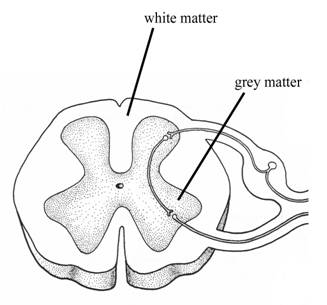The central nervous system (CNS), which includes the brain and the spinal cord, represents the largest part of the nervous system. The brain is the central control of the nervous system. The spinal cord carries nerve impulses from the brain to the body and from the body to the brain.  The brain
The brain
 The brain
The brainThe brain is the most complex organ in the body. The brain contains about 100 billion neurons each of which can have thousands of synapses. The brain is the source of what makes us human; the conscious mind. The mind is the set of cognitive processes related to perception, interpretation, imagination, memories, and language. It also regulates processes related to homeostasis such as respiration and heartbeat. An average adult human brain weighs between 1 and 1.4 kg . An adult brain uses about 20-25% of the total energy used by the body.
The brain consists of gray matter and white matter. Grey matter contains neural cell bodies, in contrast to white matter, which does not and mostly contains myelinated axons.
The brain consists of gray matter and white matter. Grey matter contains neural cell bodies, in contrast to white matter, which does not and mostly contains myelinated axons.
The brain can be classified by the processes its different parts control:
- The cerebrum is the largest part of the brain. It lies on top of the brainstem. The cerebrum controls functions that we are aware of, such as problem-solving and speech. It also controls voluntary movements.
- The cerebellum is the next largest part of the brain. It lies under the cerebrum and behind the brain stem. The cerebellum is involved in coordination and control of body movement.
- The brain stem is the smallest of the three main parts of the brain. It lies directly under the cerebrum. It controls basic body functions such as breathing, heartbeat, and temperature regulation.

In this link you can go over the brain parts
The Spinal CordThe spinal cord is a long, tube-shaped bundle of neurons. It runs from the brain stem to the lower back. The main job of the spinal cord is to carry nerve impulses back and forth between the body and brain. The spinal cord is like a two-way highway. Messages about the body, both inside and out, pass through the spinal cord to the brain. Messages from the brain instructing the body how to respond pass through the spinal cord to the body.
In this cross-section a spinal cord is the grey matter in the centre, in those funny shaped structures with horns and the white matter outside of the horns. (Remember white matter is formed by nerves travelling up and down your spinal cord and grey matter is formed by the cell bodies of the neurons).
 The brain and spinal cord are quite fragile. They are protected by a series of bone, membrane, and fluid. The bones are the skull that protected the brain and the vertebrae that protected the spinal cord. Then, there are three membranes called meninges. In these meniges there is a clear liquid called cerebroespinal fluid (CSF). This liquids forms a cushion between the soft brain tissue and the hard cranial bones.
The brain and spinal cord are quite fragile. They are protected by a series of bone, membrane, and fluid. The bones are the skull that protected the brain and the vertebrae that protected the spinal cord. Then, there are three membranes called meninges. In these meniges there is a clear liquid called cerebroespinal fluid (CSF). This liquids forms a cushion between the soft brain tissue and the hard cranial bones.
In this cross-section a spinal cord is the grey matter in the centre, in those funny shaped structures with horns and the white matter outside of the horns. (Remember white matter is formed by nerves travelling up and down your spinal cord and grey matter is formed by the cell bodies of the neurons).
 The brain and spinal cord are quite fragile. They are protected by a series of bone, membrane, and fluid. The bones are the skull that protected the brain and the vertebrae that protected the spinal cord. Then, there are three membranes called meninges. In these meniges there is a clear liquid called cerebroespinal fluid (CSF). This liquids forms a cushion between the soft brain tissue and the hard cranial bones.
The brain and spinal cord are quite fragile. They are protected by a series of bone, membrane, and fluid. The bones are the skull that protected the brain and the vertebrae that protected the spinal cord. Then, there are three membranes called meninges. In these meniges there is a clear liquid called cerebroespinal fluid (CSF). This liquids forms a cushion between the soft brain tissue and the hard cranial bones. 
No hay comentarios:
Publicar un comentario